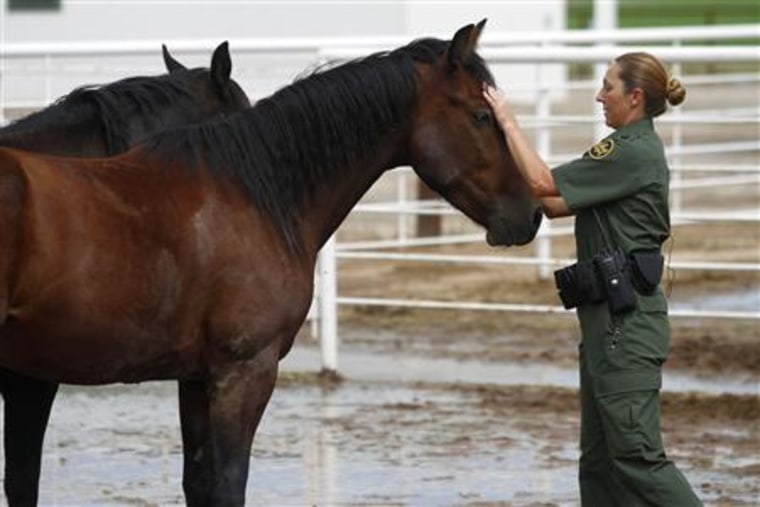Sturdy, highly strung mustangs from wild herds in the Rocky Mountains are playing a growing role as the U.S. Border Patrol takes its hunt for smugglers into the most rugged terrain on the Arizona-Mexico border.
The Tucson sector horse patrol took possession of six mustangs from Colorado this week, and is harnessing their sharp hearing, keen eyesight and stamina to track drug smugglers and illegal immigrants trekking up through areas so remote even all-terrain vehicles cannot reach them.
"They can get where ATVs can't," said Border Patrol Agent Robbie Allred, 28, after he put the horses through their paces on Friday around a corral at the 240-acre Kansas Settlement training facility near Willcox, Ariz.
"They can get where helicopters and regular agents can't," he added.
Arizona straddles the most heavily trafficked corridor for human and drug smugglers from Mexico, who frequently trek out into the wildest reaches of the high-plains desert and mountains in a bid to beat beefed up border security.
The mustangs, which arrived in Arizona on August 15 are among 32 the Border Patrol has bought since 2010 under the Noble Mustangs program, in which Colorado prison inmates break and train the animals to prepare them for sale to the public or other government agencies.
The strong, compact horses are particularly valued by Stetson and chap-wearing horse patrol agents as they are an ideal match for the forbidding wilderness south of Tucson.
"These horses, having grown up in that, are already adapted to that kind of terrain," said Bobbi Schad, the Tucson Sector's mounted patrol coordinator and one of the patrol's most experienced mounted agents.
Good hearing, eyesight
Horses are playing a greater role in border security now than at any time since the Border Patrol was founded in 1924. There are 329 mounted agents nationwide, most on the southwest border with Mexico.
The Kansas Settlement is the center of operations for mounted Border Patrol training in Arizona. Most of the Tucson Sector's 100-plus certified riders and 129 horses came through the training center, which became a Border Patrol facility four years ago after it was seized from a drug trafficker.
During training, the patrol's mustangs are exposed to flapping tarps, aircraft and gunfire -- from toy cap guns -- to accustom them to police work in the cactus-studded wilderness, often miles from the nearest road.
The mustangs, which are picked in part for their stout legs and large feet, can also hear, see and smell better than their human riders. They often alert agents to illegal immigrants or smugglers who often try to dodge arrest by hiding under trees and brush.
"Intuitively, since they were born wild, these horses are more hypersensitive. A lot of times you watch your horse," Schad said.
"At night, they learn to distinguish the sounds of a group (of drug smuggler or illegal immigrants) moving as opposed to cattle moving," she said.
Working with the new arrivals from Colorado also requires adaptability, patience and an aptitude for a particular kind of teamwork on the part of agents like Allred.
"With a motorcycle or an ATV, you just have to push a button and it does what you want," he says. "You really have to work with the horse."
